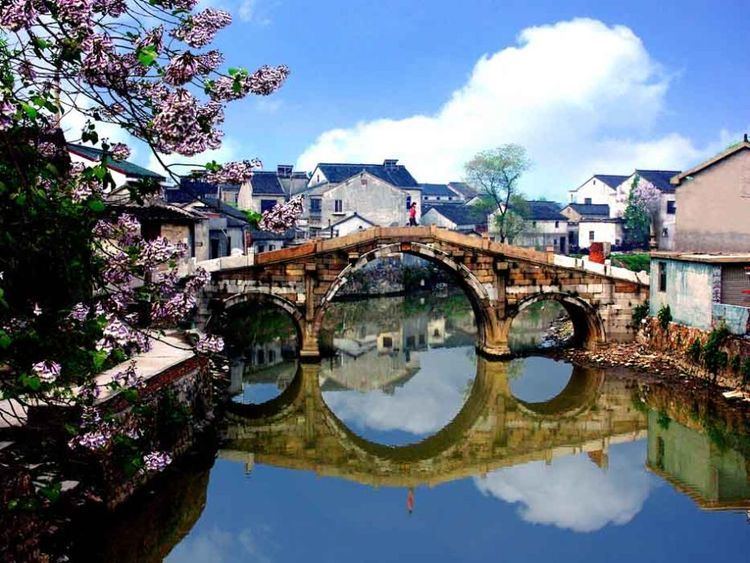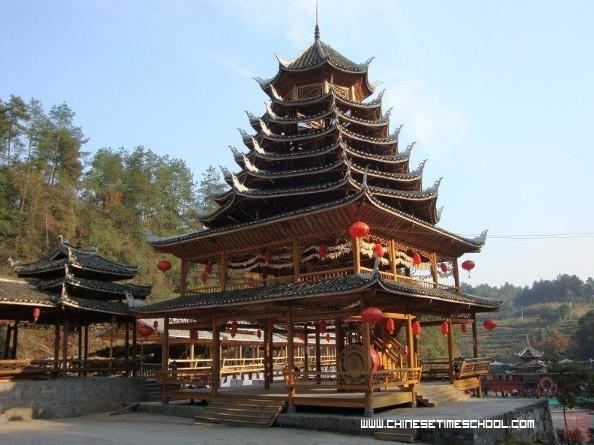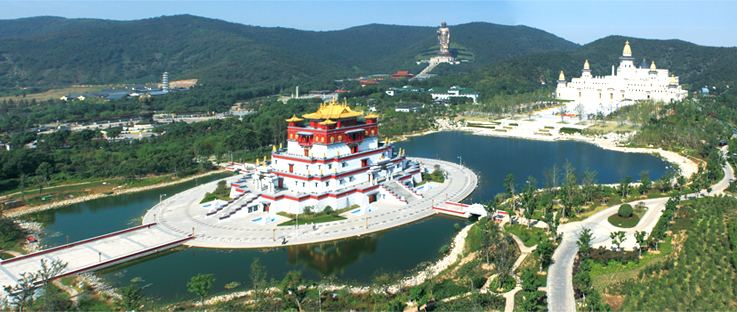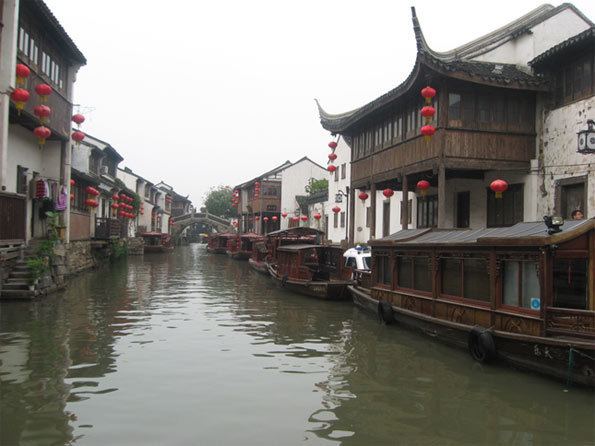Population 1.426 million (2000) Area 510 | ||
 | ||
Points of interest | ||
Country Peoples Republic of China | ||
Map of Wuxi
Wuxi (Chinese: 无锡) is an old city in southern Jiangsu province, China. The city borders two other large cities, Changzhou to the west and Suzhou to the east, and borders Zhejiang Province as well in the south. It also covers a coastline of the Yangtze River in the north and two separate coasts of Lake Tai. Wuxi is well known for being one of the birthplaces of China's modern industry and commerce, as well as the hometown of many important businessmen who have played essential roles in building commerce in Shanghai since the early 20th century.
Contents
- Map of Wuxi
- Turtle head islet parkwuxichina
- Travel wuxi china part 12
- Etymology
- Zhou Dynasty
- Spring and Autumn period and Warring States Period
- Qin and Han dynasty
- Six dynasties Tang and Song dynasties
- Yuan Ming and Qing dynasties
- 20th century
- Geography
- Climate
- Demographics
- Administration
- Economy
- Manufacturing zones
- Culture and sports
- Arts
- Tourism
- Sports
- Railways
- Air transport
- Expressways and highways
- Metro
- Universities and colleges
- High schools
- Notable people
- Wuxi street food
- Trying food in wuxi
- References

Turtle head islet parkwuxichina
Travel wuxi china part 12
Etymology

The modern name consists of the Chinese characters 无锡, literally translated "no tin". According to a myth, at the time of the Warring States, soldiers were stationed in Xishan ("tin hill") within Wuxi. While burying a pot to prepare food, a soldier found a stone plaque engraved with the words "If there is tin there is an army, there will be conflict under heaven. If there is no tin (wuxi), there will be peace under heaven," which may be the origin of the name.

Former translations to English include Wusih and Wu-hsi.
Zhou Dynasty

According to traditional Chinese historians, two Zhou princes, Taibo and Zhongyong, founded the first Chinese state in the area of Wuxi around the 11th century BC. This state of Wu (吳) had its first capital at Meili, generally thought to be the village of Meicun in Wuxi (although some records indicate a location closer to Wu's later capitals around Suzhou). Taibo and Zhongyong helped develop Wu's agriculture and waterways and the area soon flourished. Taibo died without an heir, and Zhongyong succeeded him as King of Wu. His descendants were later officially enfeoffed by the Zhou court as vassals before declaring themselves full kings again during the Spring and Autumn period.
A shrine to Taibo was set up in today's Meicun. Although the original wood structure was eventually destroyed in war, it has been rebuilt several times. A stone carved with sayings by Confucius can still be seen at the modern Taibo Shrine, whose architecture dates mostly to the Qing dynasty.
Spring and Autumn period and Warring States Period
The state of Wu became one of the strongest kingdoms during the Spring and Autumn period. Sunzi (Sun Tzu), who wrote the famous "The Art of War", came to Wu and helped the king with his military affairs. Wu was considered one of the seven strongest kingdoms during this period. Some of Sunzi's descendants still live in Sunxiang in Wuxi near the Plum Garden. However, Wu was later defeated by the state of Yue, today's Zhejiang and Fujian, which in turn was overthrown by the state of Chu and incorporated into Chu during the Warring States period.
Qin and Han dynasty
The cultural and economic center of the "Wu" area shifted to Suzhou after the reign of the first Qin dynasty emperor, Qin Shi Huang, who united China; Wuxi at that time belonged to Suzhou. During the Han dynasty, Wuxi was set up as a county by emperor Han Wudi. Historic records show that tin was discovered during the early Han era, leading to conflicts in the area. Soon, however, the tin was depleted. This was once believed to be the origin of the name Wuxi, meaning "no tin." The name was changed to Youxi (有錫), meaning "having tin", during the Wang Mang conflicts period because Wang wanted to change the name.
Six dynasties, Tang and Song dynasties
Agriculture and the silk industry flourished in Wuxi and the town became a transportation center under the early Tang Dynasty after the construction of the Grand Canal. Although Suzhou became the center of the Wu area, Wuxi was also important in the county of Wu.
Yuan, Ming and Qing dynasties
During the Ming dynasty, Wuxi became a prosperous cultural center. During the late Ming and early Qing periods, Wuxi was a center for political discussion and public opinion. Agriculture, with rice and fish were major products in the Qing period.
During the Taiping Rebellion, Wuxi was devastated by the war's destruction, like other parts of the lower Yangtze valley. Warfare disrupted planting in the region.
During the late 19th century, Wuxi became a center of the textile industry in China and one of the four most important rice markets nationwide. By 1878, Wuxi was the leading silk-producing county in Jiangsu, outstripping even Suzhou, the traditional center of that industry. In the late 19th century, Wuxi was also the regional center for the waterborne transport of grain and a major commercial center.
20th century
Between 1900 and 1940, Wuxi was considered one of the most important counties in China. In dramatist Cao Yu's well-known drama "Thunderstorm", Wuxi was mentioned several times with the comment "Wuxi is a good place". After the People's Republic of China was established by the communists in 1949, Wuxi continued to grow in importance, with increases in textile production along with both light and heavy industry. This city was considered the second most important city in Jiangsu Province after the capital Nanjing. However, its developmental model has been criticized for the environmental deterioration caused. New strategies are now under consideration to ensure its sustainable development.
Geography
The city plan, as is typical of many older Chinese cities, is of a central city with a roughly circular plan, crisscrossed with older canals, the main canal still seeing heavy barge traffic.
Wuxi itself is on an alluvial plain of deep sedimentary deposits cut between limestone foothills, making it one of the sources for "scholar's rocks", the intricately weathered stones which were used as devices for contemplation.
Climate
Wuxi is hot and humid in summer and chilly and damp in winter, with an average annual temperature of 18 °C (64 °F) and very occasional snow. Because of its proximity to the East China Sea, it has a monsoon season and receives 100 centimetres (39 inches) of rain annually.
Demographics
According to the 2010 Census, the prefecture-level of Wuxi has a population of 6,372,624, an increase of 1,192,777 from the 2000 census, giving it a population growth of 20.9% for the period 2000-2010.
Administration
The prefecture-level city of Wuxi administers seven county-level divisions, including 5 districts and 2 county-level cities. The information here presented uses the metric system and data from 2010 Census.
These districts are sub-divided into 73 township-level divisions, including 59 towns and 24 subdistricts.
Economy
Wuxi is a regional business hub with a GDP per capita of ¥126,000 in 2014, ranking it first in Jiangsu, ahead of Nanjing and Suzhou.
The city has a rapidly developing skyline with the opening of three supertall skyscrapers (300 metres or 980 feet) in 2014. These buildings are the Wuxi IFS, Wuxi Suning Plaza 1, and Wuxi Maoye City - Marriott Hotel. There are 7 other skyscrapers between 200 and 300 metres (660 and 980 feet) tall including the Yunfu Mansion.
Manufacturing zones
The city has extensive manufacturing including large industrial parks devoted to new industries. Historically a center of textile manufacturing, the city has adopted new industries such as electric motor manufacturing, MRP software development, and solar technology. Two major photovoltaic companies, Suntech Power and Jetion Holdings Ltd, are based in Wuxi, making the city a hub for solar technology in China. Bicycle manufacturing for international brands is another industry, including bicycle assembly and bicycle component manufacturing. One of the two Chinese factories of Taiwan-based brake manufacturer Tektro is in Wuxi. Hynix completed a new chip plant in Wuxi.
Since it was established in 1992, Wuxi New District (WND) has evolved to be one of the major industrial parks in China. A wide variety of components, sub-systems and original equipments are made in WND. Approximately 1200 enterprises have been registered in WND by the end of 2008. Wuxi New District provides strong support for international manufacturing operations. The Zone focuses on formation of the five pillar industries of electronic information, precision machinery and mechanical and electrical integration, bio-pharmaceuticals, fine chemicals and new materials.
Established in 1992, Wuxi Export Processing Zone is located in Wuxi New District with a planned area of 2.98 km2. The encouraged industries include electronic information, optical-mechanical-electronic-integration, precision machinery, and new materials. It is situated near to Wuxi Airport and Changzhou Port.
Culture and sports
As an important city for the "Wu" area, Wuxi is one of the art and cultural centers of "Jiangnan". Its culture bears distinctive characteristics, which can be identified in its dialect, architecture, waterway transportation and various art types.
Arts
One of the handicraft specialties of Wuxi is the production of Huishan clay figurines. and clay tea pots.
Several famous Chinese authors claiming Wuxi as their home town. Among them, most recently, Qian Zhongshu, author of Fortress Besieged, a comedy of manners set in China in the 1930s. Wuxi was the birthplace of the famous Chinese (later American) artist Chen Chi (1912—2005), in whose honor a museum has been erected in the city.
In modern times Wuxi has produced a number of cultural figures such as Hua Yanjun (1893–1950) also known as "Blind Abing" (瞎子阿炳), famous for his erhu and pipa music. Another famous musician is Liu Tianhua, who was the first to compile folk music using staff.
Tourism
Wuxi is a major tourist area of the Lower Yangtze Delta. It has natural and man-made places of interest.
The city was built on the shore of Lake Tai with the lake providing a rich tourism resource. Noted spots include Yuantouzhu (the Islet of Turtlehead) and Taihu Xiandao (Islands of the Deities). Passengers can enjoy the scenery of Lake Tai and the city center on a 115-metre (377 ft) tall Ferris wheel that takes 18 minutes to complete one revolution. At night, lighting effects are switched on around the wheel.
Literally "Tin Mountain" and "Kindhearted Mountain", Mount Xi and Mount Hui are two small hills in the western part of the city. The classic royal Ji-chang-yuan Gardens are at the foot of the hill as well as the Tianxia di er quan (天下第二泉), literally "the second spring under heaven").
The Grand Canal passes through the city. There are two canals: one is the old one that has been there since it was excavated, the other is the new canal created after 1949.
Wuxi has many private gardens or parks built by learned scholars and rich people in the past. Among these, Li Yuan, Mei Yuan are good examples that have been well preserved. Xihui Gongyuan (Xihui Park),at the foot of Xi Shan also houses historical relics, notably Jichang Garden. Lihu Park is another popular park, owing it popularity to legends that Fan Li and Xi Shi boated here. Fragrant Cedar Pavilion (Chinese: 香楠厅; pinyin: Xiāngnán tīng) is a protected site, which was dedicated in the Ming dynasty to Consort Duan by her father after her execution for involvement in an assassination attempt against the Jiajing Emperor.
Wuxi's Mashan Town was built during 16th–19th century A.D.. The town is in the northwest part of Wuxi on the west bank of the Grand Canal and at the foot of Mount Hui. The town's buildings are mainly family ancestral halls. South of the Long Mountain, near the town, is the 88 metres (289 ft) tall Grand Buddha at Ling Shan, one of the largest Buddha statues in China and the ninth tallest statue worldwide.
In the western part of Wuxi, the district is classified as a AAAAA scenic area by the China National Tourism Administration and consists of Wuxi Three State City Park, Tang City, and Shuihu City. Established in 1987, it was the first film studio in China. CCTV Wuxi Film/TV Studio used the studio for the shooting of The Three Kingdoms and Water Margins.
In Yixing (part of Wuxi), Shan Juan Cave is a four-star scenic zone. The folktale figures of Liang Shanbo and Zhu Yingtai were said to study behind the cave.
Other historical places include the former residence of Xue Fucheng, former residence of A Bin, former residence of Xu Xiake, site of Luotuo Dun, Taibo Temple and Tomb, and Donglin Shuyuan.
Sports
Wuxi has two stadiums. The old stadium is in the southern part of the city and has yet to reopen. The other is Wuxi New Stadium, which consists of a swimming stadium, soccer stadium and other facilities. It is located in the south-west part of the city, near Lake Tai. Major League Baseball has also had its main Chinese Development Center in Wuxi since 2008. At the Development Center, Major League Baseball scouts and recruits the best players in China to play at the DC in the hopes that they will eventually play professional baseball in America.
Railways
Wuxi is situated on the Shanghai–Nanjing Intercity High-Speed Railway, linking it directly with the provincial capital of Nanjing (1.5 hours), China's economic hub, Shanghai (45 minutes) and major economic hub and tourist destination Suzhou (24 minutes).
Air transport
Sunan Shuofang International Airport (IATA: WUX) opened in 2004 and serves the cities of Wuxi and Suzhou. It is situated 14 kilometres (8.7 mi) from the city centre and has direct flights to Beijing, Guangzhou, Shenzhen, Hong Kong, Taipei, Singapore, and Osaka.
Expressways and highways
Expressways:
National highways:
Provincial roads:
Metro
The Wuxi government has planned a network of 8 metro lines. Line 1 and line 2 of the Wuxi Metro began operation in 2014, on July 1 and December 28 respectively.
